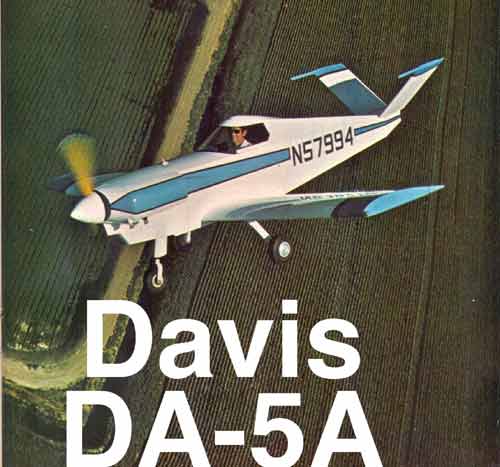
 |
The Ultimate Commuter
Plane? |
Here’s a little airplane that, at the time, I figured would be a real winner. But, I was wrong. For whatever reason, the market didn’t go for it, which I think is a shame. Today, it would make a great LSA possibility, although the stall speed would have to be worked on. For years, I’ve always figured that if I were to need an airplane for commuting to a distant office, this is what I’d build. Plans are possibly available, but you’d have to go through the DA-2A group to find them. After you've been around Leeon Davis or awhile, the thought occurs that maybe, just maybe, he got permission from that great Fed in the sky to design his own body. his own personality and his own thought patterns. He is, like the airplanes he designs and builds, possessed of nothing extraneous. Slight of frame. with an excellent strength-to weight ratio, he moves and talks with the deliberateness of a man not given to meanderings. He lives and performs. His airplanes do the same ...in spades! Leeon Davis and his unique airplanes have been with the homebuilding movement almost as long as it's been a movement. He's respected by all who know him. Unfortunately, not enough folks take the time to get to know him, or his machines. The Davis man and machine are not high profile entities. They don't jump up and grab you by the wallet to sell themselves. It's not that they don't want to be sold. It's just that so many others are jumping higher and faster that Davis is overpowered by their advertising hype. Leeon Davis works with what he has: enormous tenacity, limited finances and a fantastic eye for simplicity and performance in airplanes. And Leeon Davis succeeds.
The latest Davis machine takes all the basics of the "Davis design philosophy for cheap speed and crams them into one tiny little rectilinear package that epitomizes the performance and ease of building that Davis is always striving for. It also takes every single Davis trademark and scrunches them so close together that the new DA-5A could be a caricature of Davis design. For that matter, this could be Leeon Davis carved out of aluminum. It's lean, fast, and has no hair (Leeon's balding). Leeon's first airplane was a five-place monster. Then came the highly successful two-place DA-2A: an uncompleted four-place, and now the single hole DA-5A. However, regardless of scale, all of the airplanes have shared the same approach. Davis figures if you build it light you don't need big engines. If you don't need big engines, you don't need big tanks. If you don't need big tanks, the airframe can be lighter. Carried to the extreme, the Davis fetish for lightness would give him a lighter-than-air machine with wings. He gets his lightness from several very obvious approaches. First of all, most of his monocoque areas, such as the fuselage, eliminate stringers and some bulkheads by utilizing straight line bends to gain the basic taper. He could have done the same thing with curves and gained a little weight, but that would have frustrated his goal of keeping it simple. His entire airplane can be whacked out on a bending break with no form blocks as would be required for rounded bulkheads. The DA-5A landing gear is another area where simplicity and lightness work together. The main legs are streamlined tubing contained in a box that's filled with rubber. Thus, the legs are rigid and the shock loads are absorbed by the rubber mounts. The nose gear consists of a couple of nested steel tubes with the vertical movement limited by a stack of rubber doughnuts resembling old Ford motormounts. On the theory that most builders can bend tubing better than form fuselage frames, he has the cockpit area laced with ½ inch 4130 square tubing, which replaces any stressed aluminum members that may be too complicated for the backyard builder to bang out. There are probably some advocates of the "sleek" and "sexy" that are totally turned-off by the cubic appearance of Davis' designs. However, parked next to a piece of Wichita sheet iron, even something as small as a C-150, the Davis comes off looking as if it ought to have a glow plug sticking out of the lower cowl. When walking around it, you literally have to bend over to look at anything. Even the top of the canopy is less than chest high. Leeon has great faith in his designs and the way they perform. He feels that any klutz who can get something like a Yankee up and down can easily handle his airplanes, and he proved it by letting me fly it. As I was standing on the wing (which made me tower over the airplane). he continued to sooth my fears by telling stories of how easily his son Harold, having only a student ticket, flew the airplane. So even I should have little trouble. |